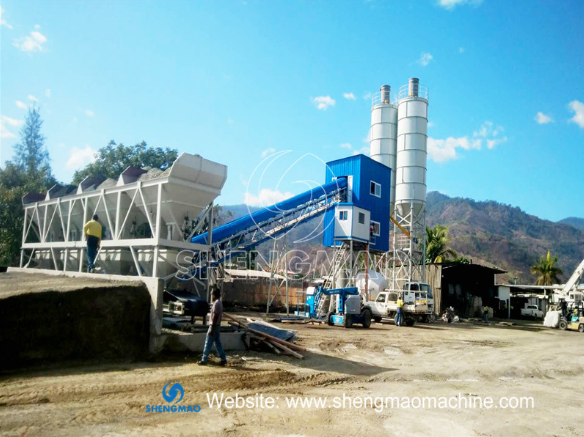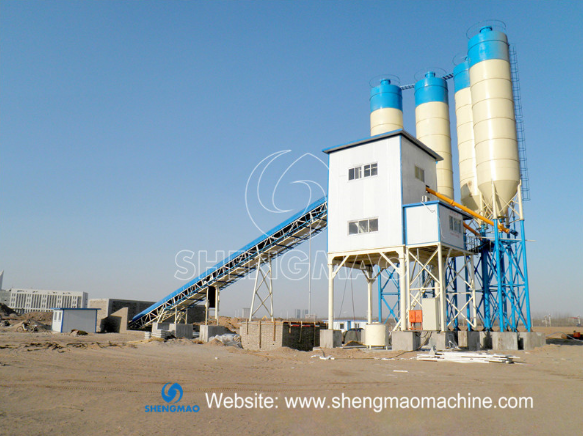What Is Concrete Batching Plant? How Does It Work?
What is a concrete batching plant?
A concrete batching plant is a machine that mixes concrete by using a rotating drum. The machine creates the right mix of cement and water. The drum rotates at high speeds, which allows the cement to be mixed with air and water at different rates, creating a homogeneous mixture.
Belt Conveyor Concrete Batching Plant
Working process of concrete batching plant?
Concrete batching plant process flow will start from the feeding of aggregates into individual bins. Size wise aggregates have to be fed into individual bins. These aggregates will be weighed individually as per the design set in the control panel. After weighing they will be transferred to the mixing unit.
There are different types of batch plants, such as continuous mix plants, semi-continuous mix plants, single-shaft batch plants, twin-shaft batch plants, and three-shaft batch plants.
This technology presents a cost-effective means of manufacturing concrete, resembling a cement plant but following a distinct process.
In terms of new technology, it involves three primary components: the preheater, the mixer, and the kiln. The preheater elevates water temperature to approximately 400 degrees Celsius, then combines it with limestone and sand. Subsequently, the mixer blends the heated water with limestone and sand to form a slurry. Finally, this slurry is poured into the kiln, where it undergoes heating to about 1,600 degrees Celsius before emerging as concrete from the kiln.
Types of Concrete Batch Plants
Concrete batch plants typically fall into two categories based on the mixing process and the timing of concrete arrival at the job site. These are the ready-mix plant and the central-mix batch plant.
Ready-Mix Batch Plants
In a ready-mix concrete batch plant, all ingredients for the concrete, except water, are blended together. Water is added during transportation to the job site. This prepares the concrete for production, with mixing taking place while the truck travels to the destination.
When opting for ready-mixed concrete, there are three primary options:
The concrete can be initially mixed at a slow speed within the truck's drum during transit. Later, the mixing drum's speed can be increased for five minutes to finalize the mixture.
The concrete can be pre-mixed at the yard and only gently stirred while being transported to the job site.
The concrete can be continually mixed at a medium speed inside the drum during transit, ensuring a complete mix by the time it arrives at the destination.
Central-Mix Batch Plants
Central-mix batch plants, also known as "wet batch" plants, represent another significant method of concrete batching. These plants mix all ingredients for the concrete before discharging the mix into a mixing truck for transport to the job site. A fixed, plant-mounted mixer, resembling a silo, is used for this purpose.
Advantages of using central-mix batch plants for concrete mixing include:
Faster mixing capabilities compared to truck mixers.
Reduced strain and wear on concrete-mixing trucks.
Consistent mixture quality achievable with a central-mix plant compared to a truck mixer.
Importance of Concrete Batching Plants
Concrete batching plants offer numerous advantages in construction endeavors:
Consistent Quality: These plants ensure a consistent and top-quality concrete production by precisely controlling the mixing process.
Enhanced Efficiency: Employing batching plants assures a reliable and efficient supply of concrete for construction projects, minimizing delays and enhancing productivity.
Tailored Mix Designs: Batching plants enable the customization of concrete mix designs, allowing for the production of various concrete types and strengths to meet specific project demands.
Cost-Efficiency: Producing concrete on-site eliminates the need to transport ready-mixed concrete from external suppliers, resulting in significant cost savings.
Environmental Impact: Incorporating recycling systems, batching plants enable the reuse of returned concrete, reducing waste and offering environmental benefits.
Conclusion
To sum up, concrete batching plants play a crucial role in construction projects by delivering a dependable and efficient supply of top-notch concrete. Understanding the different types of batching plants and their advantages aids in selecting the most suitable plant to fulfill specific construction requirements.
















